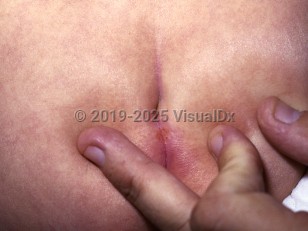Sacral dimple
Alerts and Notices
Important News & Links
Synopsis

Sacral dimples occur in about 5% of neonates and are the most common cutaneous sign of spinal dysraphism (incomplete closure of the neural tube during early embryogenesis, leading to spinal or bony abnormalities). Simple dimples are defined as midline depressions in the dermis that are less than 5 mm in diameter and within 2.5 cm of the anus. Larger lesions ("atypical dimples") and those above the gluteal cleft have been associated with spinal dysraphism.
Both sexes are equally affected. There are no differences reported among ethnic groups.
Both sexes are equally affected. There are no differences reported among ethnic groups.
Codes
ICD10CM:
L05.91 – Pilonidal cyst without abscess
SNOMEDCT:
311897005 – Sacral dimple
L05.91 – Pilonidal cyst without abscess
SNOMEDCT:
311897005 – Sacral dimple
Look For
Subscription Required
Diagnostic Pearls
Subscription Required
Differential Diagnosis & Pitfalls

To perform a comparison, select diagnoses from the classic differential
Subscription Required
Best Tests
Subscription Required
Management Pearls
Subscription Required
Therapy
Subscription Required
References
Subscription Required
Last Updated:10/24/2017
Sacral dimple

